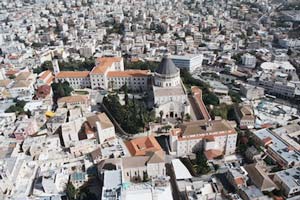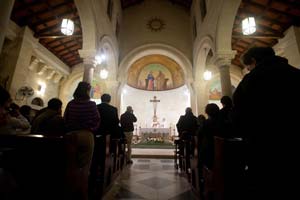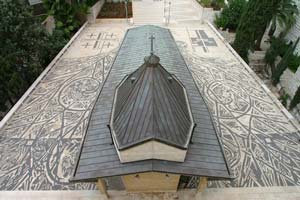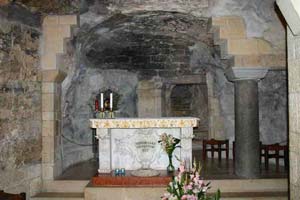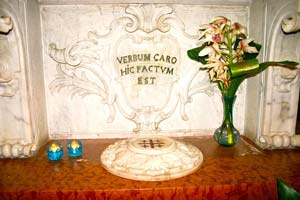Overview
Grotto and the Basilica of the Annunciation
As in the other sanctuaries appearing in the Christian memorials of the Holy Land, the Grotto of Nazareth also bears reference to the “HIC” exact location in which the gospel events occurred: here the Virgin Mary heard the words of the Annunciation; here she pronounced the fiat; here the Word became flesh; here purity and virginity fused with maternity while remaining intact.
The Grotto of the Annunciation opens like a small sanctuary, the place of the Annunciation of angel Gabriel and Mary. To reach the level of the Holy Grotto and of the small grotto beside it, you descend the seven steps of the eastern stairway and walk along the chapel of the Angel towards the stairs for ascending again; these two staircases correspond to the entrances built in the Crusader era. They would have been similar to the ones that still today lead inside the grotto of Bethlehem.
The venerated Grotto underwent many changes over the various eras in order to ensure the site could be visited and religion could be practiced there. Today its appearance is a small rocky chapel, made partly of natural rock and partly of stonework.
Guides and tours in Nazareth:
You can already see from the outside two elements of crucial importance which testify that the place was part of the ancient village. These are two large grain containers dating back to the time of Jesus and the immediately subsequent period.
These containers with circular holes of which a few traces remain, are located on the right and left of the Grotto’s entrance door, beyond the wrought iron balustrade. Moreover, above the Grotto and along the sides, the Crusader pillars that supported the arches of the large church can be seen.
On entering the Grotto, you can make out the remains of the natural rock that formed the room, as well as sections of stonework partly rebuilt in shiny white stone. The ceiling, that underwent a few changes in the past to make the Grotto seem like a chapel, is slightly rounded.
See more Catholic Shrines and pilgrimages in the Holy Land.
See top 15 Catholic shrines in the world.
In the Crusader era, the Grotto was blocked off and recarved on the outside to allow a new holy building to be inserted; part of the vault, probably collapsed, was also replaced with Crusader stonework. Recently, holes have been made to ensure a good ventilation of the room since it undergoes significant deterioration due to the high level of humidity inside.
Three columns were inserted to support the pillar that the Crusaders built above the Grotto: two can be seen on the left, outside the Grotto’s new wall and one on the inside, broken and suspended. The largest column of the two outer ones was referred to by the pilgrims as “the Angel column”; the broken one inside was called “the Virgin’s column”, because it was believed to indicate exactly the place where Mary was sitting during the Annunciation. The column that sticks up from the roof of the Grotto was split open in the Ottoman period, because it was thought to contain a treasure.
The main altar bears the inscription «Verbum caro hic factum est», “HERE” the word became flesh. Entering on the right, there is a small apse created for one of the five altars that were in the Grotto and in the Chapel of the Angel until halfway through the last century.
The apse was plastered several times and the pilgrims made various inscriptions there that have unfortunately been lost due to the strong deterioration of the walls. The room to the north, further inside the Grotto, is a semicircular shape and has preserved an altar dedicated to Saint Joseph over the centuries. It now contains a column holding the tabernacle. Behind the altar of the Annunciation, a grotto better known as “Mary’s kitchen” can be reached via a stairway built into the wall.
Annunciation – Gospel of Luke (Luke 1: 26-38)
The evangelist Luke is particularly focused on the narration of the events concerning the Holy Family, dedicating the first two chapters of his Gospel to them. The annunciation of the birth of Jesus, the Saviour, is brought by the angel Gabriel to Mary, a young Israelite woman from a small village in Galilee.
The first word of the angel’s greeting to Mary is “Chaîre” in Greek which can be translated as “Rejoice” or “Hail”. It expresses the joy of the moment since God, through Mary, “daughter of Zion” of the prophecy of Zephaniah (Zephaniah 3:14), fulfils his promise of salvation, long awaited by the chosen people. As indicated by Benedict XVI, «this exclamation from the angel – we could say – marks the true beginning of the New Testament, the Christian message of Good News» (Benedict XVI, “The Infancy Narratives”, 2011, pp. 36-37).
See more Catholic Shrines and pilgrimages in the Holy Land.
See top 15 Catholic shrines in the world.
Mary becomes the “servant of the Lord” and becomes his “house”, offering herself to God for the purpose of the Salvation. «The words, “behold, I am the handmaiden of the Lord”, express the fact that from the outset she accepted and understood her own motherhood as a total gift of self, a gift of her person to the service of the saving plans of the Most High.» (John Paul II, “Redemptoris Mater”, no. 39) As a result, Mary becomes a model for the church and all the believers.
In the sixth month of Elizabeth’s pregnancy, God sent the angel Gabriel to Nazareth, a town in Galilee, to a virgin pledged to be married to a man named Joseph, a descendant of David. The virgin’s name was Mary. The angel went to her and said, “Greetings, you who are highly favored! The Lord is with you.”
Mary was greatly troubled at his words and wondered what kind of greeting this might be. 30But the angel said to her, “Do not be afraid, Mary; you have found favor with God. You will conceive and give birth to a son, and you are to call him Jesus. He will be great and will be called the Son of the Most High. The Lord God will give him the throne of his father David, and he will reign over Jacob’s descendants forever; his kingdom will never end.” “How will this be,” Mary asked the angel, “since I am a virgin?”
The angel answered, “The Holy Spirit will come on you, and the power of the Most High will overshadow you. So the holy one to be born will be calledb the Son of God. Even Elizabeth your relative is going to have a child in her old age, and she who was said to be unable to conceive is in her sixth month. For no word from God will ever fail.” “I am the Lord’s servant,” Mary answered. “May your word to me be fulfilled.” Then the angel left her.
Let us remain close in the same prayer! May the Lord bless you abundantly!
Video
Grotto of the Annunciation
As in the other sanctuaries appearing in the Christian memorials of the Holy Land, the Grotto of Nazareth also bears reference to the “HIC” exact location in which the gospel events occurred: here the Virgin Mary heard the words of the Annunciation; here she pronounced the fiat; here the Word became flesh; here purity and virginity fused with maternity while remaining intact.
The Grotto of the Annunciation opens like a small sanctuary, the place of the Annunciation of angel Gabriel and Mary. To reach the level of the Holy Grotto and of the small grotto beside it, you descend the seven steps of the eastern stairway and walk along the chapel of the Angel towards the stairs for ascending again; these two staircases correspond to the entrances built in the Crusader era. They would have been similar to the ones that still today lead inside the grotto of Bethlehem.
The venerated Grotto underwent many changes over the various eras in order to ensure the site could be visited and religion could be practiced there. Today its appearance is a small rocky chapel, made partly of natural rock and partly of stonework.
You can already see from the outside two elements of crucial importance which testify that the place was part of the ancient village. These are two large grain containers dating back to the time of Jesus and the immediately subsequent period. These containers with circular holes of which a few traces remain, are located on the right and left of the Grotto’s entrance door, beyond the wrought iron balustrade. Moreover, above the Grotto and along the sides, the Crusader pillars that supported the arches of the large church can be seen.
On entering the Grotto, you can make out the remains of the natural rock that formed the room, as well as sections of stonework partly rebuilt in shiny white stone. The ceiling, that underwent a few changes in the past to make the Grotto seem like a chapel, is slightly rounded. In the Crusader era, the Grotto was blocked off and recarved on the outside to allow a new holy building to be inserted; part of the vault, probably collapsed, was also replaced with Crusader stonework. Recently, holes have been made to ensure a good ventilation of the room since it undergoes significant deterioration due to the high level of humidity inside.
Three columns were inserted to support the pillar that the Crusaders built above the Grotto: two can be seen on the left, outside the Grotto’s new wall and one on the inside, broken and suspended. The largest column of the two outer ones was referred to by the pilgrims as “the Angel column”; the broken one inside was called “the Virgin’s column”, because it was believed to indicate exactly the place where Mary was sitting during the Annunciation. The column that sticks up from the roof of the Grotto was split open in the Ottoman period, because it was thought to contain a treasure.
The main altar bears the inscription «Verbum caro hic factum est», “HERE” the word became flesh, part of the Franciscan sanctuary of 1730. Entering on the right, there is a small apse created for one of the five altars that were in the Grotto and in the Chapel of the Angel until halfway through the last century. The apse was plastered several times and the pilgrims made various inscriptions there that have unfortunately been lost due to the strong deterioration of the walls. The room to the north, further inside the Grotto, is a semicircular shape and has preserved an altar dedicated to Saint Joseph over the centuries. It now contains a column holding the tabernacle. Behind the altar of the Annunciation, a grotto better known as “Mary’s kitchen” can be reached via a stairway built into the wall.
Archaeology Museum of Nazareth
The Museum is located in the area to the north of the Basilica of the Annunciation, near the rooms that were originally part of the ancient Bishop’s Palace from the crusade era. It conserves the collection of all the most interesting pieces unearthed during the archaeological digs, and was founded by P. Viaud in 1910 to illustrate the history of the excavations.
The museum is accessible via the rose garden, alongside the entrance to the Franciscan monastery. Along the route towards the entrance, a number of architectural findings from the Byzantine Basilica and crusade are on display.
The museum, which can be visited on request, is made up of a large exhibition hall and the archaeological area covered by the suspended platform.
A map, with overlapping layers, illustrates, by colour coding, the findings in the area. This basic reconstruction helps visitors to better understand the changes that occurred and the perimeters within which they moved: the village with caves, silos and corridors are yellow; the remains of the pre-Byzantine and Byzantine era are in blue; the perimeters of the crusade building are in red; and the new shrine is in white.
Let us remain close in the same prayer! May the Lord bless you abundantly!
Let us remain close in the same prayer! May the Lord bless you abundantly!
Convent Holy Masses:
Basilica of the Annunciation
- Every Saturday in the Grotto: times 11.00 am.
- Every Sunday in the Grotto: times 7:00 am (Arabic) – 5:00 pm (Arabic) – 6:00 pm (Arabic)
- Every Sunday in the Upper Basilica: time 10:00 am (Arabic)
- Every day in the Grotto: time 6: 30 am (Italian)
St. Joseph’s Church
- Every Sunday: time 8:30 am (Arabic)
- Every day: time 7:15 am (Arabic)
Let us remain close in the same prayer! May the Lord bless you abundantly!
Let us remain close in the same prayer! May the Lord bless you abundantly!
- The Basilica of the Annunciation opening times
Lower Basilica (Grotto): 5:45 am – 9:00 pm
Upper Basilica: 8:00 am – 6:00 pm - St. Joseph’s Church opening times: 7: 00 am – 6:00 pm
- Archaeological Museum opening times: Monday to Saturday: 8:00 am -12:00 am / 2:00 pm -6:00 pm (winter closing time 5:00 pm)
Permission to visit the Mensa Christi Church should be obtained from the Guardian of the Convent
Let us remain close in the same prayer! May the Lord bless you abundantly!
Let us remain close in the same prayer! May the Lord bless you abundantly!
The new shrine
Already at the end of the First World War the Custodia proposed, to Pope Pius IX, the idea of building a more worthy shrine, in the place of the Annunciation. Many years later, in 1954 the propitious opportunity arose: the first centenary of the proclamation of the dogma of the Immaculate Conception. To celebrate this anniversary, padre Custode Giacinto Faccio decided to start the work, which involved demolishing all the 18th century structures and conducting archaeological investigations of the ancient ruins.
The renowned architect Antonio Barluzzi, who had designed major shrines for the Custodia, such as the Getsemani, Tabor and Dominus Flevit, was the first to be assigned for the design of the new shrine. An article with drawings of his designs was published in the magazine of Holy Land in 1954. The design envisaged a great church with central layout, covered by a cupola and flanked by four bell towers; it was designed, as was the Church of the Holy Sepulchre, with the worshipped grotto at the centre.
The rediscovery of the ancient village and the archaeological remains of the various buildings of worship that followed over the centuries, revealed an age-old and uninterrupted Marian veneration, and thus became an indispensable element to be considered in the design of the new shrine. Along these lines was also the Holy See, from which came the invitation to best conserve the remains of the ancient village and various churches. This recommendation led the Custodia to promote a new project, this time assigned to the Italian architect Giovanni Muzio, on proposal by Custodian Father Alfredo Polidori, who valued the experience of Muzio in the design of religious buildings, in particular for the Friars Minor, for whom he had designed the church of Santa Maria Mediatrice in Rome, with the annexed Curia Generalizia.
The needs to be met were manifold: to build a new Marian shrine that could welcome millions of pilgrims from all over the world; to conserve as far as possible the crusade, Byzantine and pre-Byzantine remains in view, as testimony to the long-standing worship of the location; to overcome difficult topographical conditions due to the steep slopes of the hills; to create a practical location, easily managed even by a limited number of religious figures and which could also be host to the parish community activities of Nazareth. The architect became so impassioned with the project that he wavered his fee.
He designed a church founded on the crusade walls and divided onto two levels, so that on the lower level followers could stay and pray in front of the grotto of the Incarnation of the Word, in a simple but capacious area, while a large upper church would be used to celebrate the glorification of Mary over the centuries and the continents. For this reason, he chose to decorate the walls depicting the various Marian events that have occurred across the various regions of the world. Muzio also thought of a large central oeil-de-boeuf window open above the Grotto, so that the two churches could merge into one, crowned by a polygonal cupola in the shape of an inverted crown of flowers terminating in a skylight, with the function of indicating, like a star, the Holy Place from afar.
With the approval of the Holy See, the works started and proceeded uninterrupted. The Custodia met the onerous costs of the work also thanks to the generous response of many donors who, through the pages of the magazine “The Holy Land” and the precious help of the Commissaries of the Holy Land, were kept up-to-date with the phases of construction. Works to prepare the site started in 1959 and the agreement with the contracted firm was signed in September of 1960. In 1964, Pope Paul VI, during his pilgrimage to the Holy Land, visited the new Shrine under construction.
On Sunday 23 March 1969, after eight years of work, the shrine was finally consecrated in the presence of Cardinal Gabriele Maria Garrone – at the time Prefect of the sacred Congregation for Catholic Education -, of the Latin Patriarch of Jerusalem S.B. Monsignor Gori, of the Minister General of the Order of Franciscan Friars Father Costantino Koser, of the Custos of the Holy Land Very Reverend P. Alfonso Calabrese. The custos who alternated during the planning and production of the work were P. Giacinto Faccio, P. Angelo Lazzeri, P. Alfredo Polidori, P. Lino Cappiello and P. Alfonso Calabrese.
Upper and Lower Basilica
The entrance to the lower church is very impressive, and calls to prayer. The space has been deliberately designed to give prominence to the Grotto and the archaeological remains that tradition attributes to the site of the Annunciation and the Incarnation of the Savior. The centrality of the cave allows visitors to embrace at a glance the whole environment. The reinforced concrete structure rises on the plan of ancient Crusader basilica, which was brought to light the perimeter of the excavation of the first half of the twentieth century. The three apses are reconstructed on the original XII Century. At the center of the main apse is placed a bronze cross; in the north they depict Mary’s parents, Saints Joachim and Anne, and to the south is shown a picture of the Annunciation century, preserved in the Holy Cave from 1754 to 1954, the year of the demolition of the eighteenth-century church.
The Grotto of the Annunciation is surrounded by a wrought iron gate and is surmounted by a canopy suspended, decorated with reliefs in gilded copper depicting the scene of the Annunciation. The venerated Grotto is at a level lower than the current basilica . In the Sanctuary built by the Franciscans in the eighteenth century., it was located under the presbytery and was reached by a ladder placed frontally. After the archaeological excavations of the last century, it was decided to leave in view of the Holy Cave and the ancient remains, to give even more prominence to the revered place since the early centuries of Christianity. They are visible fragments of walls and mosaics of the original prayer room the later Byzantine church. A spa, found under the Byzantine mosaics, probably belongs to the original housing complex that included the cave, perhaps later used for the baptismal rites. In front of the Holy Grotto, inside the perimeter of the Byzantine church, was prepared the space for liturgical celebrations. The twilight allows the visitor to enjoy the contrast with the light that reveals the location of the Announcement, illuminated by the white stone of the cave.
Upper Basilica
On entering the bright upper Basilica, it is immediately evident that there is more space than in the lower Basilica. All the iconography is dedicated to the celebration of Christ, Mary and the Franciscan order. The lower area can be reached via two spiral stairways located at the sides of the entrance. The main entrance is located to the north of the building, in front of the large roof terrace that protects the archaeological remains of the ancient village and connects the square of the Basilica to the convent and parish space.
There are two doors located to the north: one on the left, known as the Mater Christi or the “Ecclesia ex Circumcisione”, the other, to the right, known as the “Mater Ecclesiae” or the “Ecclesia ex Gentibus”.
The tympanum on the left door portrays the nativity scene in glazed ceramic while the one on the right door shows Mary with her cloak open, welcoming the faithful. Both high reliefs are a work by Angelo Biancini. The bronze shutters, a work by the Dutch sculptor Niel Steenbergen, depict the two strains of the church: Jewish and non-Israelite. On the left door, that represents the church of Jewish origin, there is a representation of the tree of Jesse, the Annunciation, the Adoration of the Shepherds and the Call of Peter. In the second, the one on the right, there are biblical images that recall the non-Israelite strain of the church: the experience of the prophet Jonah, the visit of the Three Kings, Pentecost and the conversion of Saul.
The octagonal baptistery is located outside in front of the door. The floor of the square is decorated with the representation of the Canticle of the Sun of Saint Francis of Assisi and, with other symbols that recall the Franciscan spirituality.
The space inside the basilica is bathed in bright light and the vibrant colours of the various Marian images that decorate the church. The light enters from the dome and the wide windows inspired by Mary.
The central apse is decorated by the majestic mosaic with the representation of the statement of the Creed that declares the Church to be “One Holy, Catholic and Apostolic”.
The theme of the Virgin, Mother of God, is present in lots of the decorations: even in the bronze candelabra located in the presbytery where the history of salvation from the origins to the Roman church is depicted. The side apses contain the chapels dedicated to the “Most Blessed Sacrament” and the “Custody of the Holy Land” with the Franciscan saints.
The walls of the Church depict a celebration of Mary: images of the Virgin coming from various sanctuaries of the world follow to mark out the Incarnation of Christ, as presented in all the cultures of the world. The panels come from various countries of the world. On the right wall: Cameroun, Hungary, Brazil, the United States, Poland, Spain, Italy. On the left wall: England, Australia, Argentina, Venezuela, Lebanon, Japan, Canada. The windows of the south and west façades represent various elements of the Annunciation and are realised by the Parisian artist Max Ingrand: the shape of the pointed arch reflects the style than can be found in old Gothic cathedrals.
On the marble floor, a work by the artist Adriano Alessandrini, the Marian dogma defined and privileges granted over the centuries by the Council Fathers and the Popes, starting with the Council of Ephesus in 431 AD, in which the divine maternity of Mary was established, are depicted.
Finally, we can turn our attention to the starlit oculus that opens onto the remains of the Grotto of the Annunciation.
Let us remain close in the same prayer! May the Lord bless you abundantly!
The Church of Saint Joseph
Passing alongside the Franciscan monastery towards the north, we reach the Shrine dedicated to the memory of Saint Joseph, husband of Mary and putative father of Jesus.
The ancient tradition ties this Basilica with the memory of the carpenter’s home in Nazareth. Among the oldest witness accounts, there is that of the pilgrim Arculfus (7th century), who speaks of the existence of a Shrine known as that of Nutrition. Here Jesus was brought up and educated by his parents. The other tradition links to location to the “workshop of Joseph”, a memory recovered by the
Franciscans on their arrival at Nazareth in the 17th century.
Now, on the remains of a crusade church, stands a Neo-Romanesque building, designed by the German architect fr. Wendelin Hinterkeuser, and constructed between 1911 and 1914. Up until that time, a small chapel stood in the same place, built by the Franciscans in 1754.
In the archaeological digs of the late 1700s a bath was uncovered, with a mosaic base, supposedly an ancient baptistery, and a series of grottos and silos visible in the crypt of the church.
Church of the Archangel Gabriel
There is another sanctuary in Nazareth linked to the Eastern tradition and dedicated to the Archangel Gabriel. It commemorates the first announcement of the Archangel to the Virgin, which occurred at a spring. This tradition, which originates in the Infancy Gospel of James, began to spread from the second century.
There is evidence of a church built in this place only since the Crusades (12th century). However, it is possible to think that an earlier sanctuary might have been built already in Byzantine times. The current place of worship, owned by the Greek-Orthodox Church, was built in 1750 by some monks, on top of the ruins of the Crusader Sanctuary destroyed by the Muslims. In 1767, the wooden iconostasis was placed in the presbytery, along with valuable icons of the Jerusalem school.
In the last century, between 1977 and 1978, two Romanian artists decorated the walls of the sanctuary with biblical scenes.
Crossing the church leads to a crypt at the bottom of which flows the water from the spring. The walls of the crypt are decorated with four trefoil arches and covered in marble and enamel. A niche at the side of the altar preserves the spring that flows directly from the rock.






